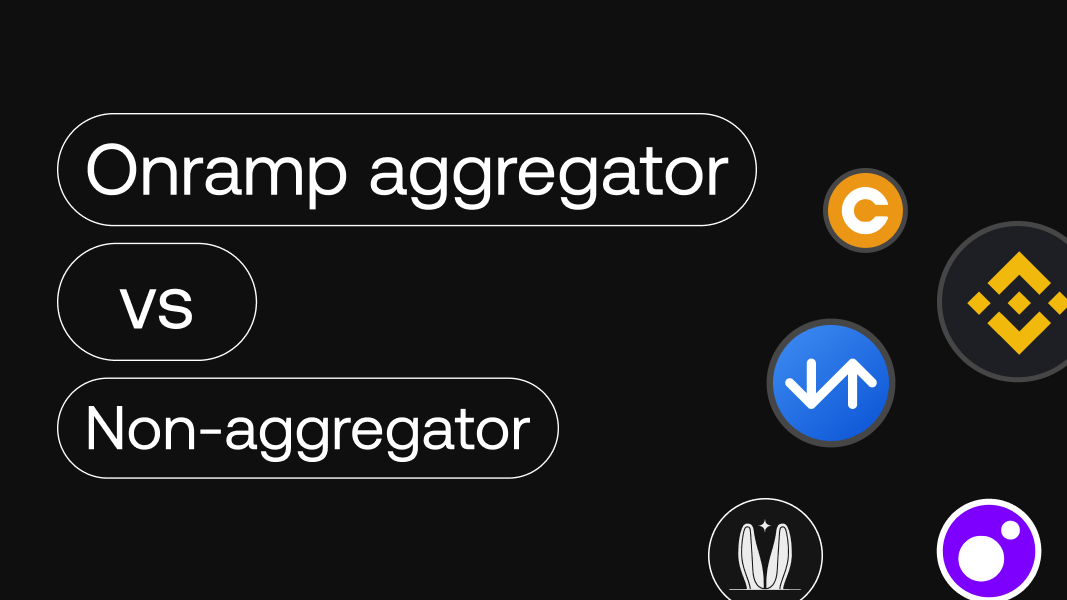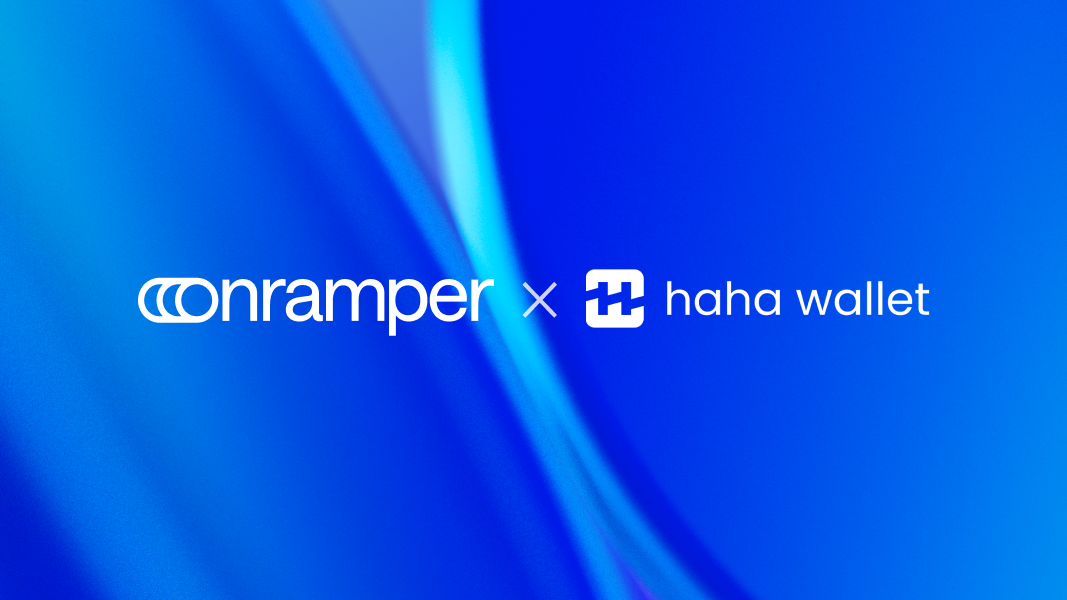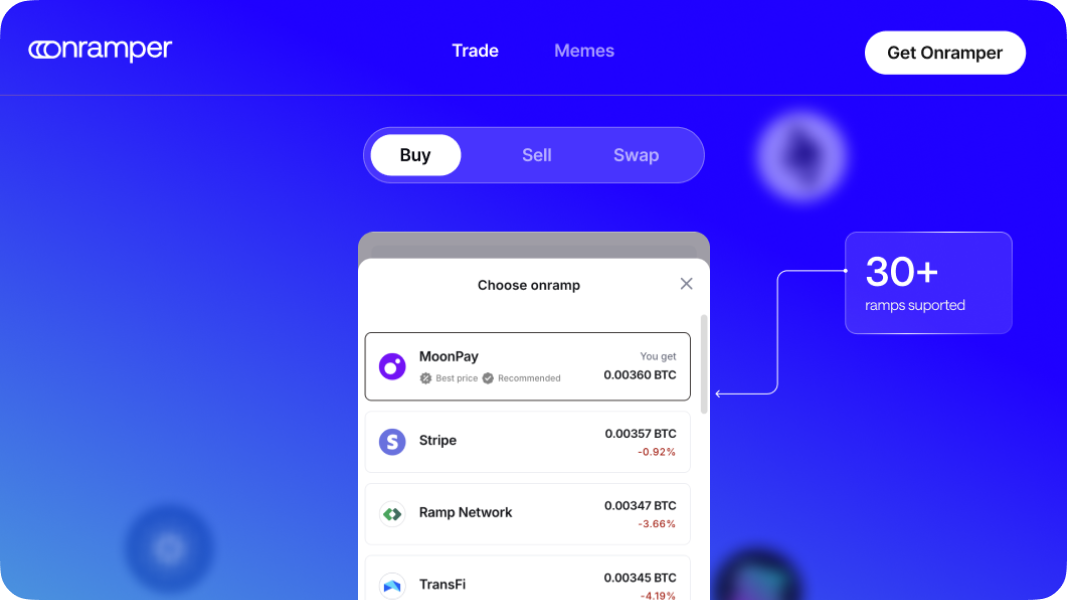Blog
Why use a fiat-to-crypto onramp aggregator?
One onramp will never be enough. Neither will five. An aggregator can solve the inherent issues the industry faces today.

The promise of the fiat-to-crypto onramp is an enticing one: with minimal effort, your platform can integrate a widget that allows your customers to turn their fiat money into bitcoin, ether or any other crypto.
In practice, however, onramping is far from the seamless process it’s made out to be. Your provider doesn’t want you to know this, but an estimated 50% of transactions fail after KYC has been passed.
That’s a little alarming, isn’t it? It gets worse. Our October 2022 report identified that abandonment rates during the checkout process can reach as high as 90%.
Why aren’t the onramps working?
To be clear, they do work. And when they do, they’re an excellent way to get new customers up and running in the crypto ecosystem. The problem is getting them to work consistently.
It’s impossible for any given onramp to cater to all demographics. With so much global variance in payment methods, proof of address/identity documents, and fiat currencies used, every solution must make trade-offs.
Unfortunately, those trade-offs come at the expense of user experience for a majority of customers — who are repeatedly hit with the dreaded ‘transaction failed’ error.
Aggregation fixes this
Simply switching your provider won’t solve an issue that impacts every player in the industry.
Introducing multiple onramps could reduce dropouts, in theory, but it’s an expensive solution that isn’t guaranteed to work:
- Integrating and maintaining several stacks eats a significant amount of resources
- Customers will still need to find an onramp that works for them via trial and error
The right aggregator can remove these points of friction: resulting in lower integration costs for you, and streamlined onboarding into the crypto ecosystem for your customers.
The secret sauce: dynamic transaction routing
At the heart of aggregation lies an engine that can identify (and understand) your customers profile and their needs — their location, the fiat currency they’re using, the KYC documentation they have available, etc. The engine takes these factors into account before intelligently matching them with the onramp most likely to ensure a successful transaction.
Our research shows that there are 70+ such inputs that can influence a fiat-to-crypto swap. To be effective, the aggregator’s engine must consider them all.
Truly global coverage
Want consistent completion in fiat-to-crypto transactions? Increase access to local payment methods.
Across the board, these routes are tied to higher success rates. But, frustratingly, there isn’t a single onramp that can provide access to them all — different solutions excel in local payment methods for different regions.
By aggregating them, you instantly broaden your access to location-specific rails. Which, in turn, allows you to equip your customer segments with the best path to crypto available.
Lower fees. Higher outputs.
You might know that your onramp’s fee isn’t actually representative of what your customers are paying. Far from it.
When presented with a single onramp, they’re tied to its conversion rates, its bid-ask spreads and its chosen network fees. All of these hidden costs add up to take a chunk out of the amount of crypto received.
Here, aggregation works as it does on any booking website: it weighs up the different onramps and (all) their rates to calculate the cheapest option — meaning that your customers get the best bang for their buck on every transaction.
Onboarding made easy
The crypto landscape can be difficult enough for newcomers to grasp. Their very first step shouldn’t be a massive hurdle.
With a fiat onramp aggregator, it won’t be. You’ll make sure your customers are repeatedly enjoying seamless swaps (for better rates, too) — all while reducing your own technological overhead.
Want to find out how Onramper can turbocharge your success rates with streamlined aggregation? Book a call with our experts today.
Other articles

Wello Joins Onramper’s Network to Expand Crypto Onboarding in Nigeria
Collaboration strengthens Onramper’s Nigerian payment rails for all partners
December 19, 2025 – Onramper, the world’s leading fiat-to-crypto onramp aggregator, announced that it has integrated Wello, a global fiat on- and off-ramp provider, to increase crypto accessibility in Nigeria. By integrating with Onramper, Wello’s localized payment rails will reach a wider audience, beginning with Nigeria and expanding across Asia. This partnership is part of the broader plan to bring stablecoin-powered payments to local markets around the world.
Nigeria remains one of the most active crypto markets globally, but ensuring reliable and high-performing fiat-to-crypto rails in the country remains a challenge. By incorporating Wello’s localized infrastructure, Onramper strengthens its presence in the region and delivers smoother, more successful conversion paths for every partner operating in Nigeria.
“Wello will strengthen the global coverage of our aggregation engine,” said Thijs Maas, CEO of Onramper. “Its dependable and deeply localized infrastructure gives our partners, and their users, the onboarding experience they expect, in Africa and beyond.”
Wello brings strong regional expertise across Africa and the Middle East, with payment rails designed for fast-growing, high-adoption crypto markets. Its localized approach reduces failed transactions and improves uptime for Nigerian users.
Onramper continues to lead the onramp aggregation space, connecting more than 30 global fiat gateways and supporting over 2,000 digital assets. All partners integrated with Onramper will automatically gain access to Wello’s rails, unlocking improved payment methods, stronger reliability, and broader coverage in Nigeria without requiring any technical changes.
“Our goal is to build dependable stablecoin payment rails for users around the world,” said Helen Hai, Co-Founder at Wello. “Partnering with Onramper makes our infrastructure available to more wallets, exchanges, and platforms, unlocking a smoother, more efficient onboarding experience.”
Onramper’s global network supports more than 130 payment methods across 190+ countries. Its smart routing engine recommends the best available conversion in real time, maximizing the likelihood of a successful transaction and helping users receive the most crypto for their fiat.
To learn more, please visit onramper.com and wello.tech.
About Onramper
Onramper is the leading fiat-to-crypto payments aggregator, providing a turnkey API-based solution for dynamically routing fiat-to-crypto onramp flows based on algorithms optimizing for conversion, fees and payment methods. Onramper’s platform allows users of clients to buy 2000+ digital assets, in over 190 countries with over 170 payment methods in 120 currencies, with advanced routing options and unified analytics. The company is based in the Netherlands. To learn more about Onramper, visit www.onramper.com.
About Wello
Wello brings real utility to stablecoins. With compliant fiat on/off ramps, instant QR payments, and cross-border settlement. Wello’s mission is to bridge Web3 with real-world payments, empowering people to send global, spend local, effortlessly.

HaHa Wallet Partners with Onramper to Expand Access to the Monad Ecosystem
Partnership follows Monad Mainnet launch to unlock global onboarding
AMSTERDAM, Dec. 17, 2025 — Onramper, the world’s leading fiat-to-crypto onramp aggregator, today announced a strategic partnership with HaHa Wallet, next-generation, Monad-native crypto wallet, to broaden global accessibility for users engaging with Monad ecosystem.
Through the integration, HaHa Wallet users can now buy crypto using over 130 local payment methods across 190+ countries, benefiting from competitive rates and optimized fees. Following the launch of Monad’s public Mainnet in November 2025, the partnership makes it easier for users worldwide to enter Monad and begin trading, bridging, and exploring dApps.
HaHa Wallet has quickly become a leading gateway into Monad, offering a fast, intuitive, and reward-driven user experience. With Onramper’s global payments coverage and smart routing engine, users can move from fiat to crypto in just a few clicks and start interacting onchain.
“Realizing Monad’s full potential depends on frictionless onboarding,” said Thijs Maas, CEO of Onramper. “Our partnership with HaHa Wallet brings trusted, localized payment access directly into the Monad ecosystem. Together, we’re making it easier than ever for people everywhere to get started on Monad.”
Monad’s unique architecture enables parallel transaction execution, delivering faster speeds, quicker finality, and lower fees without sacrificing decentralization. Combined with Onramper’s global payment infrastructure, HaHa Wallet provides users with a streamlined entry point into Monad’s high-performance blockchain environment.
“Our focus is building the simplest possible entry point into the Monad Ecosystem,” said Mu Li, founder of HaHa Wallet. “Integrating Onramper allows us to offer trusted local payment methods, helping users get onchain quickly and confidently, no matter where they are in the world.”
Onramper continues to lead the onramp aggregation space, connecting more than 30 global fiat gateways and supporting over 2,000 digital assets, driving greater accessibility and inclusivity across Web3.
To learn more, please visit onramper.com and haha.me
About Onramper
Onramper is the leading fiat-to-crypto payments aggregator, providing a turnkey API-based solution for dynamically routing fiat-to-crypto onramp flows based on algorithms optimizing for conversion, fees and payment methods. Onramper’s platform allows users of clients to buy 2000+ digital assets, in over 190 countries with over 130 payment methods in 120 currencies, with advanced routing options and unified analytics. The company is based in the Netherlands. To learn more about Onramper, visit www.onramper.com.
About HaHa Wallet
HaHa Wallet is the Monad native, high performance smart wallet built to maximise how users earn and participate on chain. Purpose built for Monad’s low latency, parallel execution environment, HaHa delivers lightning fast swaps, deep native integrations with Monad dApps and ecosystem campaigns, and seamless access to multiple EVM chains through a single non custodial experience. Users earn Karma for meaningful on chain activity, unlocking rewards, ecosystem access, and future HaHa token utility, positioning HaHa Wallet as the primary consumer gateway to Monad and a rewards driven hub for Web3 participation.
For media enquiries, contact:

Introducing our new crypto trading portal: the easiest way to buy, sell and swap
Buying crypto should be simple. Selling and swapping should feel just as easy. That’s why we’re leveling up the Onramper experience to make this a reality.
Meet our new crypto portal, the world’s simplest all-in-one trading platform. It brings buying, selling and swapping together in one place with the best available fees and full global coverage.
One place for everything
It’s easy for trading flows to feel scattered, with buying, swapping and selling all living in different places. We set out to fix that..
Our portal brings everything together so the entire journey stays clear and straightforward from start to finish. You can now:
- Buy crypto with 170+ payment methods
- Sell back to fiat
- Swap 100K+ assets across 50+ networks, with 11+ liquidity providers
All from one clean, intuitive interface.

Always the best fees, automatically
Crypto pricing moves fast, with fees constantly shifting based on payment method, geography, KYC requirements and liquidity. Our smart routing engine tracks all of it in real time and selects the best provider automatically.
We do the work, and you get the best fees with the highest chance of transaction success.
Any payment method. Any user.
A global product requires global payment coverage. The new portal supports 175+ payment methods including cards, Apple Pay, Google Pay, bank transfers, regional options and alternative methods found in high-growth markets.
Since payment preferences vary by region, the interface automatically highlights the options that perform best in your area. This keeps the experience fast, familiar and easy for any user, anywhere.

Buy any memecoin on Solana with MoonGate
The rise of memecoins has changed what’s expected from a trading experience. People want speed, simplicity and access to the long tail of new tokens.
By integrating MoonGate directly into the portal, we deliver exactly that. You can:
- Sign in with Google or Apple to generate a wallet instantly
- Discover trending Solana tokens
- Buy or swap into any memecoin in seconds
No separate setup and no manual wallet creation. Just instant access.

This is just the beginning
This portal isn’t an add-on. It’s a dedicated page built around a single widget that supports every trade type in one unified experience. And it’s only the first version.
We’ll continue adding new features that streamline the entire trading journey. From smarter token discovery to personalized payment suggestions, our goal is to create the smoothest crypto trading experience possible.
Try the full experience here: https://onramper.webflow.io/buy



















